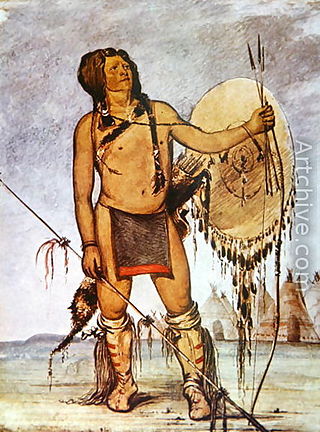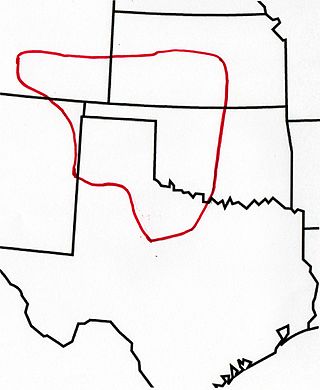
Francisco Vázquez de Coronado was a Spanish conquistador and explorer who led a large expedition from what is now Mexico to present-day Kansas through parts of the southwestern United States between 1540 and 1542. Vázquez de Coronado had hoped to reach the Cities of Cíbola, often referred to now as the mythical Seven Cities of Gold. His expedition marked the first European sightings of the Grand Canyon and the Colorado River, among other landmarks. His name is often Anglicized as Vasquez de Coronado or just Coronado.

Juan de Oñate y Salazar was a Spanish conquistador from New Spain, explorer, and colonial governor of the province of Santa Fe de Nuevo México in the viceroyalty of New Spain. He led early Spanish expeditions to the Great Plains and Lower Colorado River Valley, encountering numerous indigenous tribes in their homelands there. Oñate founded settlements in the province, now in the Southwestern United States.
Lipan Apache are a band of Apache, a Southern Athabaskan Indigenous people, who have lived in the Southwest and Southern Plains for centuries. At the time of European and African contact, they lived in New Mexico, Colorado, Oklahoma, Texas, and northern Mexico. Historically, they were the easternmost band of Apache.

The Wichita people, or Kitikiti'sh, are a confederation of Southern Plains Native American tribes. Historically they spoke the Wichita language and Kichai language, both Caddoan languages. They are indigenous to Oklahoma, Texas, and Kansas.

Plains Indians or Indigenous peoples of the Great Plains and Canadian Prairies are the Native American tribes and First Nation band governments who have historically lived on the Interior Plains of North America. While hunting-farming cultures have lived on the Great Plains for centuries prior to European contact, the region is known for the horse cultures that flourished from the 17th century through the late 19th century. Their historic nomadism and armed resistance to domination by the government and military forces of Canada and the United States have made the Plains Indian culture groups an archetype in literature and art for Native Americans everywhere.

Comanche history In the 18th and 19th centuries the Comanche became the dominant tribe on the southern Great Plains. The Comanche are often characterized as "Lords of the Plains." They presided over a large area called Comancheria which they shared with allied tribes, the Kiowa, Kiowa-Apache, Wichita, and after 1840 the southern Cheyenne and Arapaho. Comanche power and their substantial wealth depended on horses, trading, and raiding. Adroit diplomacy was also a factor in maintaining their dominance and fending off enemies for more than a century. They subsisted on the bison herds of the Plains which they hunted for food and skins.
Quivira was a province of the ancestral Wichita people, located near the Great Bend of the Arkansas River in central Kansas, The exact site may be near present-day Lyons extending northeast to Salina.
The Deer Creek/Bryson Paddock Sites are the remains of 18th century fortified villages of the Wichita tribe located along the Arkansas River in Kay County, Oklahoma.
Teyas were a Native American people living near what is now Lubbock, Texas, who first made contact with Europeans was the 1541 Francisco Vásquez de Coronado Expedition.

Etzanoa is a historical city of the Wichita people, located in present-day Arkansas City, Kansas, near the Arkansas River, that flourished between 1450 and 1700. Dubbed "the Great Settlement" by Spanish explorers who visited the site, Etzanoa may have housed 20,000 Wichita people. The historical city is considered part of Quivira.
Jusepe Gutierrez ,) was a Native Nahua guide and explorer. He was the only known survivor of the Umana and Leyba expedition to the Great Plains in 1594 or 1595. In 1599 he guided Vicente de Zaldivar and in 1601 Governor Juan de Oñate on expeditions to the plains.
Antonio Gutiérrez de Humana and Francisco Leyva de Bonilla, Spanish colonists, made an unauthorized expedition to the Great Plains in 1594 or 1595. An Indian, Jusepe Gutierrez, was the only survivor and the source of fragmentary information about the expedition. The route Humana and Leyva followed can not be determined with certitude, but it probably included traveling to what is today Texas, Oklahoma, and Kansas.
Jumanos were a tribe or several tribes, who inhabited a large area of western Texas, New Mexico, and northern Mexico, especially near the Junta de los Rios region with its large settled Indigenous population. They lived in the Big Bend area in the mountain and basin region. Spanish explorers first recorded encounters with the Jumano in 1581. Later expeditions noted them in a broad area of the Southwest and the Southern Plains.
Juan Sabeata was a Jumano Indian leader in present day Texas who tried to forge an alliance with the Spanish or French to help his people fend off the encroachments of the Apaches on their territory.
The Tompiro Indians were Pueblo Indians living in New Mexico. They lived in several adobe villages east of the Rio Grande Valley in the Salinas region of New Mexico. Their settlements were abandoned and they were absorbed into other Pueblo Nations in the 1670s.
The Taovaya tribe of the Wichita people were Native Americans originally from Kansas, who moved south into Oklahoma and Texas in the 18th century. They spoke the Taovaya dialect of the Wichita language, a Caddoan language. Taovaya people today are enrolled in the Wichita and Affiliated Tribes, a federally recognized tribe headquartered in Anadarko, Oklahoma.
The Battle of the Two Villages was a Spanish attack on Taovaya villages in Texas and Oklahoma by a Spanish army in 1759. The Spanish were defeated by the Taovaya and other Wichita tribes with assistance from the Comanche.
The Edwards Archaeological Site is an archaeological site in Beckham County, Oklahoma, near the town of Carter. The site is part of the Edwards Complex, a culture which flourished in this area from about 1400 to 1650. The site was a Native American (Indian) village and included dwellings surrounded by a round fortification. Large amounts of waste material, such as tools and bones, have been collected from the site, indicating prolonged inhabitation by a large group. Pottery fragments and obsidian and turquoise artifacts found at the site suggest that its inhabitants traded with Puebloan peoples.

The Southern Plains villagers were semi-sedentary Native Americans who lived on the Great Plains in western Oklahoma, Texas, Kansas, and southeastern Colorado from about AD 800 until AD 1500.
Vicente de Zaldívar was a Spanish soldier and explorer in New Mexico. He led the Spanish force which perpetrated the Acoma Massacre at the Acoma Pueblo in 1599. He led or participated in several expeditions onto the Great Plains.